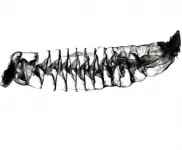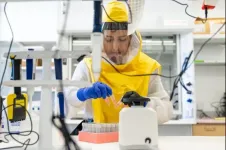(Press-News.org) Any life identified on planets orbiting white dwarf stars almost certainly evolved after the star's death, says a new study led by the University of Warwick that reveals the consequences of the intense and furious stellar winds that will batter a planet as its star is dying. The research is published in Monthly Notices of the Royal Astronomical Society, and lead author Dr Dimitri Veras will present it today (21 July) at the online National Astronomy Meeting (NAM 2021).
The research provides new insight for astronomers searching for signs of life around these dead stars by examining the impact that their winds will have on orbiting planets during the star's transition to the white dwarf stage. The study concludes that it is nearly impossible for life to survive cataclysmic stellar evolution unless the planet has an intensely strong magnetic field - or magnetosphere - that can shield it from the worst effects.
In the case of Earth, solar wind particles can erode the protective layers of the atmosphere that shield humans from harmful ultraviolet radiation. The terrestrial magnetosphere acts like a shield to divert those particles away through its magnetic field. Not all planets have a magnetosphere, but Earth's is generated by its iron core, which rotates like a dynamo to create its magnetic field.
"We know that the solar wind in the past eroded the Martian atmosphere, which, unlike Earth, does not have a large-scale magnetosphere. What we were not expecting to find is that the solar wind in the future could be as damaging even to those planets that are protected by a magnetic field", says Dr Aline Vidotto of Trinity College Dublin, the co-author of the study.
All stars eventually run out of available hydrogen that fuels the nuclear fusion in their cores. In the Sun the core will then contract and heat up, driving an enormous expansion of the outer atmosphere of the star into a 'red giant'. The Sun will then stretch to a diameter of tens of millions of kilometres, swallowing the inner planets, possibly including the Earth. At the same time the loss of mass in the star means it has a weaker gravitational pull, so the remaining planets move further away.
During the red giant phase, the solar wind will be far stronger than today, and it will fluctuate dramatically. Veras and Vidotto modelled the winds from 11 different types of stars, with masses ranging from one to seven times the mass of our Sun.
Their model demonstrated how the density and speed of the stellar wind, combined with an expanding planetary orbit, conspires to alternatively shrink and expand the magnetosphere of a planet over time. For any planet to maintain its magnetosphere throughout all stages of stellar evolution, its magnetic field needs to be at least one hundred times stronger than Jupiter's current magnetic field.
The process of stellar evolution also results in a shift in a star's habitable zone, which is the distance that would allow a planet to be the right temperature to support liquid water. In our solar system, the habitable zone would move from about 150 million km from the Sun - where Earth is currently positioned - up to 6 billion km, or beyond Neptune. Although an orbiting planet would also change position during the giant branch phases, the scientists found that the habitable zone moves outward more quickly than the planet, posing additional challenges to any existing life hoping to survive the process.
Eventually the red giant sheds its entire outer atmosphere, leaving behind the dense hot white dwarf remnant. These do not emit stellar winds, so once the star reaches this stage the danger to surviving planets has passed.
Dr Veras said: "This study demonstrates the difficulty of a planet maintaining its protective magnetosphere throughout the entirety of the giant branch phases of stellar evolution."
"One conclusion is that life on a planet in the habitable zone around a white dwarf would almost certainly develop during the white dwarf phase unless that life was able to withstand multiple extreme and sudden changes in its environment."
Future missions like the James Webb Space Telescope due to be launched later this year should reveal more about planets that orbit white dwarf stars, including whether planets within their habitable zones show biomarkers that indicate the presence of life, so the study provides valuable context to any potential discoveries.
So far no terrestrial planet that could support life around a white dwarf has been found, but two known gas giants are close enough to their star's habitable zone to suggest that such a planet could exist. These planets likely moved in closer to the white dwarf as a result of interactions with other planets further out.
Dr Veras adds: "These examples show that giant planets can approach very close to the habitable zone. The habitable zone for a white dwarf is very close to the star because they emit much less light than a Sun-like star. However, white dwarfs are also very steady stars as they have no winds. A planet that's parked in the white dwarf habitable zone could remain there for billions of years, allowing time for life to develop provided that the conditions are suitable."
INFORMATION:
Durham, Toronto and Princeton Universities have teamed up with NASA and the Canadian Space Agency to build a new kind of astronomical telescope. SuperBIT flies above 99.5% of the Earth's atmosphere, carried by a helium balloon the size of a football stadium. The telescope will make its operational debut next April and when deployed should obtain high-resolution images rivalling those of the Hubble Space Telescope. Mohamed Shaaban, a PhD student at the University of Toronto, will describe SuperBIT in his talk today (Wednesday 21 July) at the online RAS National Astronomy Meeting (NAM 2021).
Light from a distant galaxy can travel for billions of years to reach our telescopes. In the final ...
CHICAGO --- A woman's heart health before she becomes pregnant is strongly related to her likelihood of experiencing a complication during her pregnancy or labor, reports a new Northwestern Medicine study.
The study examined the presence of four cardiovascular risk factors in women before they became pregnant: smoking, unhealthy body weight, hypertension and diabetes. With the presence of each additional risk factor, the likelihood that the woman would experience an adverse pregnancy outcome got increasingly higher. Those adverse outcomes include maternal intensive care unit (ICU) admission, preterm birth, low birthweight and fetal ...
Contrary to what popular media portrays, we actually don't know much about what sharks eat. Even less is known about how they digest their food, and the role they play in the larger ocean ecosystem.
For more than a century, researchers have relied on flat sketches of sharks' digestive systems to discern how they function -- and how what they eat and excrete impacts other species in the ocean. Now, researchers have produced a series of high-resolution, 3D scans of intestines from nearly three dozen shark species that will advance the understanding of how sharks eat and digest their food.
"It's high time ...
Being more physically active and spending fewer hours per day sitting watching TV is linked to a substantially lower risk of developing obstructive sleep apnoea (OSA), according to new research published in the European Respiratory Journal [1]. It is the first study to simultaneously evaluate physical activity and sedentary behaviour in relation to OSA risk.
OSA is a condition where breathing stops and starts many times during sleep. It reduces oxygen levels in the blood and common symptoms include snoring, disrupted sleep and feeling excessively tired. ...
Study offers first global estimates of the number of children who experienced the death of a parent, grandparent, or primary caregiver from COVID-19.
Researchers estimated figures based on COVID-19 mortality data from March 2020 through April 2021, and national fertility statistics for 21 countries, and extrapolated findings to produce global estimates.
Findings suggest 1 million children have lost a parent, 1.1 million have lost a parent or custodial grandparent, and more than 1.5 million have lost a parent, custodial grandparent, or other secondary familial caregiver from COVID-19.
Authors call for urgent investments in services to support children who have lost their parents and caregivers.
An estimated ...
New research published in Anaesthesia (a journal of the Association of Anaesthetists) by researchers from the University of Bristol can help to improve the efficiency of surgery and help tackle the growing backlog of surgery caused by the COVID-19 pandemic. During the pandemic, the number of patients waiting for routine surgery in the UK has almost doubled with more than 5.3 million people awaiting surgery including more than 300,000 waiting more than a year.
A contributory factor is that COVID-19 precautions have led to many operating theatres working at 75-50% of normal working efficiency. Staff working in operating theatres have been required to take special precautions at the start and end of operations to allow viral particles ...
More than 1.5 million children around the world are estimated to have lost at least one parent, custodial grandparent, or grandparent who lived with them due to death related to COVID-19 during the first 14 months of the pandemic, according to a study published today in The Lancet. The study highlights orphanhood as an urgent and overlooked consequence of the pandemic and emphasizes that providing evidence-based psychosocial and economic support to children who have lost a caregiver must be a key part of responding to the pandemic.
The analysis used mortality and fertility data to model rates of COVID-19-associated orphanhood (death of one or both parents) and deaths of custodial and co-residing grandparents (ages 60-84) from March 1, 2020 to April 30, 2021, across 21 countries. This study ...
Metabolic bone diseases, including osteoporosis, when bones lose their mass and become so fragile that they could be damaged while sneezing or under little stress, are called the silent epidemic of the 21st century. A person does not even know about his illness before the first symptom - it can be a fracture of the spine or the neck of the hip. According to statistics, every third woman and every fifth man after 50 have osteoporosis. Thus, it is promising to search for and obtain substances and materials for implants that have osteoinductive properties and are capable of initiating the processes of transformation of stem cells into bone.
Certain trace elements, such as calcium and magnesium, influence the processes of bone regeneration ...
In the early days of the pandemic, scientists at Virginia Tech created a COVID-19 testing laboratory and novel test for the virus from scratch.
They not only developed a test in-house that avoided the reagent supply shortages that hampered testing efforts nationwide, but also used 3D-engineered supplies and stable storage media, enabling samples to be transported to rural sites in Virginia without the need for constant refrigeration.
This novel protocol for transforming a research laboratory into a testing operation capable of processing more than 130,000 ...
Spider silk is said to be one of the strongest, toughest materials on the Earth. Now engineers at Washington University in St. Louis have designed amyloid silk hybrid proteins and produced them in engineered bacteria. The resulting fibers are stronger and tougher than some natural spider silks.
Their research was published in the journal ACS Nano.
To be precise, the artificial silk -- dubbed "polymeric amyloid" fiber -- was not technically produced by researchers, but by bacteria that were genetically engineered in the lab of Fuzhong Zhang, a professor ...




